-
-
List of Articles
-
Open Access Article
1 - Technological Absorption Capacity of the Iranian Economy
Behzad Salmani Firuz Fatahi Parviz Mohammadzade Akbar Anrajani Khosroshahi -
Open Access Article
2 - An Ambidextrous Learning Model and Fitness of it with Different Forms of Knowledge Assets of Organization
Davood Hoseinpour Yousef Mohammadi moghadam Alireza Koshki Jahromi Rahman Mohammadi -
Open Access Article
3 - Effective Factors in Organizational Agility
Milad Aghaee Reza Aghaei -
Open Access Article
4 - The Impact of Knowledge Management on Organizational Innovation
Hasan Dehghani -
Open Access Article
5 - The Investigation of Effect of Entrepreneurial Self-efficacy on Strengthening Entrepreneurial Intention of Students (Case Study: Students of Payam-e noor University, Bijar city)
Mehran Foladi Hamzeh Baghani -
Open Access Article
6 - Achieving Performance Measurement Framework for Science and Technology Parks
Saeed Shadan -
Open Access Article
7 - Comparative Study of Technology Transfer Models
Hassanali Aghajani Ramin Farzadfar -
Open Access Article
8 - Suggest a Model for the Academic Humanities Spin off Incubators, Move to the Fourth Generation University
Taraneh Enayati Alireza Aulipour
-
The rights to this website are owned by the Raimag Press Management System.
Copyright © 2017-2025







